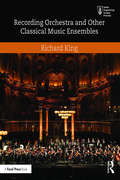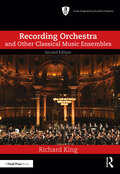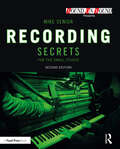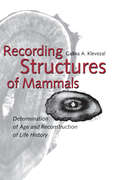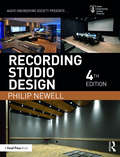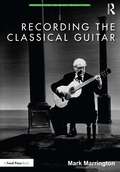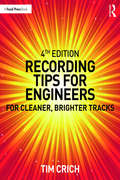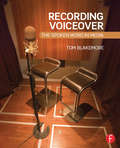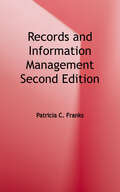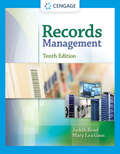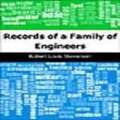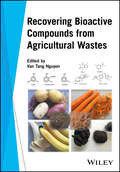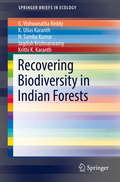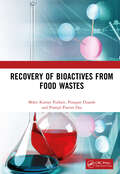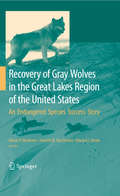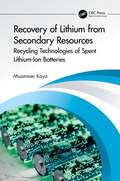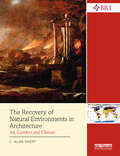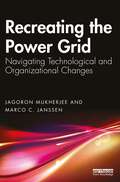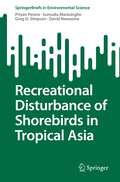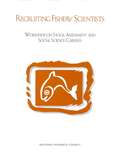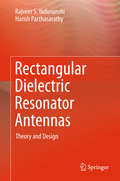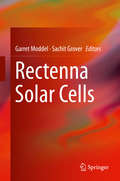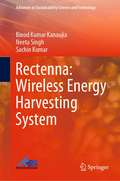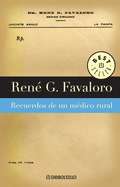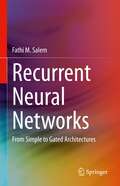- Table View
- List View
Recording Orchestra and Other Classical Music Ensembles (Audio Engineering Society Presents)
by Richard KingRecording Orchestra and Other Classical Music Ensembles explores techniques and methodologies specific to recording classical music. Whether a newcomer or a seasoned engineer looking to refine their skills, this book speaks to all levels of expertise and covers every aspect of recording symphonic and concerto repertoire, opera, chamber music, and solo piano. With a focus on the orchestra as an instrument and sound source, this book features sections on how to listen, understanding microphones, concert halls, orchestra seating arrangements, how to set up the monitoring environment, and how to approach recording each section of the orchestra. Recording Orchestra provides concise information on preparing for a recording session, the role of the producer, mixing techniques, and includes a "quick-start" reference guide with suggested setups aimed at helping introduce the reader to the recording process. A companion website, featuring audio examples of various techniques, reinforces concepts discussed throughout the book. The content of the book includes: Clear, practical advice in plain language from an expert in classical music recording, multiple Grammy award winning recording engineer, and university professor The "secret of recording": a collection of practical recording techniques that have been proven to be highly successful in the field, on many occasions Never before published information written by an industry veteran with over twenty five-years of experience in classical music recording Specific techniques and strategies for recording orchestra, opera, wind symphony, chorus, string quartet, and other common classical music ensembles.
Recording Orchestra and Other Classical Music Ensembles (ISSN)
by Richard KingRecording Orchestra and Other Classical Music Ensembles explores techniques and methodologies specific to recording classical music. Whether the reader is a newcomer or a seasoned engineer looking to refine their skills, this book speaks to all levels of expertise and covers every aspect of recording symphonic and concerto repertoire, opera, chamber music and solo piano.With a focus on the orchestra as an instrument and sound source, Recording Orchestra and Other Classical Music Ensembles features sections on how to listen, understanding microphones, concert halls, orchestra seating arrangements, how to set up the monitoring environment and how to approach recording each section of the orchestra. Offering concise information on preparing for a recording session, the role of the producer and mixing techniques, whilst a "quick-start" reference guide with suggested setups also helps to introduce the reader to the recording process. Online Instructor and Student Resources, featuring audio and video examples of various techniques, further reinforces the concepts discussed throughout the book.This new edition has updated and expanded material, including new chapters on classical crossover projects, film score recording and immersive/3D recording and mixing, as well as a number of new case studies, making this an essential guide for students, researchers and professionals recording classical music.
Recording Secrets for the Small Studio (Sound On Sound Presents...)
by Mike SeniorIn this new edition, discover how to achieve commercial-grade recordings, even in the smallest studios, by applying power-user techniques from the world’s most successful producers. Recording Secrets for the Small Studio is based on the backroom strategies of more than 250 famous names. This thorough and down-to-earth guide leads you through a logical sequence of practical tasks to build your live-room skills progressively from the ground up, with user-friendly explanations that introduce technical concepts on a strictly need-to-know basis. On the way, you’ll unravel the mysteries of many specialist studio tactics and gain the confidence to tackle a full range of real-world recording situations. Specifically designed for small-studio enthusiasts, this book provides an intensive training course for those who want a fast track to releasing quality results, while the chapter summaries, assignments, and extensive online resources are perfect for school and college use. Learn the fundamental principles of mic technique that you can apply in any recording scenario – and how to avoid those rookie mistakes that all too often compromise the sonics of lower-budget productions. Explore advanced techniques which help industry insiders maintain their competitive edge even under the most adverse conditions: creative phase manipulation, improvised acoustics tweaks, inventive monitoring workarounds, and subtle psychological tricks. Find out where you don’t need to spend money, as well as how to make a limited budget really count. Make the best use of limited equipment and session time, especially in situations where you’re engineering and producing single-handed. Pick up tricks and tips from celebrated engineers and producers across the stylistic spectrum, including Steve Albini, Neal Avron, Roy Thomas Baker, Joe Barresi, Howard Benson, Tchad Blake, T-Bone Burnett, Geoff Emerick, Brian Eno, Paul Epworth, Shawn Everett, Humberto Gatica, Imogen Heap, Ross Hogarth, Trevor Horn, Rodney Jerkins, Leslie Ann Jones, Eddie Kramer, Jacquire King, Daniel Lanois, Sylvia Massy, Alan Meyerson, Justin Niebank, Gary Paczosa, Tony Platt, Jack Joseph Puig, David Reitzas, Bob Rock, Laura Sisk, Fraser T Smith, Young Guru, and many more. Now extensively expanded and updated, with new sections on contact mics, software instruments, squash mics, and ensemble depth distortion.
Recording Structures of Mammals
by Galina A. KlevezalThis text focuses on the principles and methods of using growth layers formed in teeth and bones of mammals to make a judgement on essential traits of the animal's life history. In nearly all mammalian species, including man, the age of individuals can be determined from the number of growth layers and, at least in some of them, it is possible to estimate the season of an animal's birth and death, age of sexual maturation, periodicity of reproduction, certain feeding habits and other aspects of the individual's biology. It is also possible, from tooth-enamel analysis, to assess doses of radiation accumulated by animals and human beings during their lifetime.;This book is intended for zoologists, wild-game biologists and zoo archaeologists, but some of the sections could also be of interest for anthropologists, radioecologists and conservation biologists.
Recording Studio Design (Audio Engineering Society Presents)
by Philip NewellRecording Studio Design, Fourth Edition explains the key principles of successful studio design and construction using straightforward language and the use of practical examples appreciated by readers of previous editions. Updated to reflect new industry standards, this fourth edition addresses improvements in cinema sound, with specific attention paid to B-chain electroacoustic response and calibration. Using over 50 years’ experience, author Philip Newell provides detail on the practical aspects of recording in various environments, not only exploring the complex issues relating to the acoustics but also providing real-world solutions. While the book contains detailed discussions about performing rooms, control rooms, and mobile studios, concepts of the infrastructures are also discussed, because no studio can perform optimally unless the technical and human requirements are adequately provided for. In this new edition, sound for cinema provides a platform for highlighting many, wider electroacoustic topics in a way that is relatively easy to visualise. The way in which sound and vision interact is an important aspect of many modern multimedia formats. The new edition includes: A new Chapter 22 that will thoroughly reflect recently published SMPTE investigations which will drastically impact standards for cinema sound; The inclusion of new academic research and its practical applications; An entire new illustrated chapter on room construction principles; and The consolidation of ideas which were only emerging when the earlier editions were published.
Recording the Classical Guitar (Perspectives on Music Production)
by Mark MarringtonRecording the Classical Guitar charts the evolution of classical guitar recording practice from the early twentieth century to the present day, encompassing the careers of many of the instrument’s most influential practitioners from acoustic era to the advent of the CD. A key focus is on the ways in which guitarists’ recorded repertoire programmes have shaped the identity of the instrument, particularly where national allegiances and musical aesthetics are concerned. The book also considers the ways in which changing approaches to recording practice have conditioned guitarists’ conceptions of the instrument’s ideal representation in recorded form and situates these in relation to the development of classical music recording aesthetics more generally. An important addition to the growing body of literature in the field of phonomusicology, the book will be of interest to guitarists and producers as well as students of record production and historians of classical music recording.
Recording Tips for Engineers: For Cleaner, Brighter Tracks
by Tim CrichRecording Tips for Engineers, Fourth Edition provides the knowledge needed to become a proficient audio engineer. With years of experience working with big name rock stars, author Tim Crich shares his expertise and gives all the essential insider tips and shortcuts. A tool for engineers of all levels, this humorous, easy-to-read guide is packed with practical advice using real-life studio situations, bulleted lists, and clear illustrations. It will save valuable time and allow for fast, in-session reference. Additional resources are available on the companion website (www.routledge/cw/crich.com). The fourth edition has been updated to: Lead discussions of modern file storage and processes for uploading, downloading, sharing, and transferring files and data. Address digital audio workstations. Provide expanded coverage on room treatment.
Recording Voiceover: The Spoken Word in Media
by Tom BlakemoreThe only book on the market to specifically address its audience, Recording Voiceover is the comprehensive guide for engineers looking to understand the aspects of capturing the spoken word. Discussing all phases of the recording session, Recording Voiceover addresses everything from microphone recommendations for voice recording to pre-production considerations, including setting up the studio, working with and directing the voice talent, and strategies for reducing or eliminating distracting noise elements found in human speech. Recording Voiceover features in-depth, specific recommendations for recording radio and television commercials, corporate communications, documentaries, tracks for gaming and animation, radio drama, interviews and roundtable discussions. A discussion of the voice in film and television is also included. Special attention is paid to the final release format and its impact on recording strategies. Exploration of using telephone interfaces – including both analogue and digital ISDN, as well as recording across the internet – is included.
Records and Information Management
by Patricia C. FranksAs Information Management put it, "On the strength of its currency and coverage alone, Franks' book is poised to take over as the recommended go-to reference for both students and RIM professionals for many years to come." <p><p>The new second edition cements this work's status as an up-to-date classic, its content updated and expanded to address emerging technologies, most notably blockchain, and evolving standards and practices. Inside, Franks presents complete coverage of the records and information lifecycle model, encompassing paper, electronic (databases, office suites, email), and new media records (blogs, chat messages, and software as a service). <p><p>Informed by an advisory board of experts in the field and with contributions by noted authorities, the text addresses such key topics as the origins and development of records and information; the discipline of information governance and developing a strategic records management plan; creation/capture and classification; retention strategies, inactive records management, archives, and long-term preservation; access, storage, and retrieval; electronic records and electronic records management systems; the latest on rapidly evolving technologies such as web records, social media, and mobile devices; vital records, disaster preparedness and recovery, and business continuity; monitoring, auditing, and risk management; and education and training. <p><p>This book's authoritative blend of theory and practice makes it a matchless resource for everyone in the archives and records management field. Instructor/trainer extras include a set of ready-to-go, customizable PowerPoint slides to accompany the text.
Records Management
by Judith Read Mary Lea GinnRECORDS MANAGEMENT, Tenth Edition, provides a comprehensive introduction to the complex field of records management. The text features sound principles of records and information management that include the entire range of records; physical (paper), image records, and electronic media used in computerized systems. <P><P>Part I, Records and Information Management, provides thorough coverage of alphabetic filing rules, as well as methods of storing and retrieving alphabetic, subject, numeric, and geographic records. The rules agree with the latest standard filing guidelines presented by ARMA International. Part II, Electronic Records Management, introduces electronic records file management as well as classifying electronic files using metadata, taxonomies, and file plans; and the use of magnetic, optical and solid state media through the phases of the records management life cycle. <P><P>A new chapter introduces Enterprise Content Management (ECM) and describes how Microsoft SharePoint is used in Records Management. Part III, RIM Program Administration, delves into the records and information management (RIM) program components and guidelines; with expanded coverage of information governance, social media, and the records and information manager's responsibilities. In addition to content based on ARMA International standards and best practices, the text features realistic database activities, profiles of real-world professionals, and practical advice and examples to prepare students for career success. <P><P>The Tenth Edition features extensive updates, including a restructuring of the chapters to reflect the growing importance of electronic records management.
Records of a Family of Engineers
by Robert Louis StevensonTrajectory presents classics of world literature with 21st century features! Our original-text editions include the following visual enhancements to foster a deeper understanding of the work: Word Clouds at the start of each chapter highlight important words. Word, sentence, paragraph counts, and reading time help readers and teachers determine chapter complexity. Co-occurrence graphs depict character-to-character interactions as well character to place interactions. Sentiment indexes identify positive and negative trends in mood within each chapter. Frequency graphs help display the impact this book has had on popular culture since its original date of publication. Use Trajectory analytics to deepen comprehension, to provide a focus for discussions and writing assignments, and to engage new readers with some of the greatest stories ever told. "Records of a Family of Engineers" by Robert Louis Stevenson recounts the history of the Stevenson family and lighthouse engineering.
Recovering Bioactive Compounds from Agricultural Wastes
by Van Tang NguyenA guide to the extraction, isolation and purification of bioactive compounds from agricultural wastes, and their applications Recovering Bioactive Compounds from Agricultural Wastes offers a guide to the many uses of agricultural wastes from the production of major food types including tea, coffee, cacao, cashew, fruit and vegetables, wine, edible oils, sugar, starch and more. Written by a noted expert in the field, the text explores the various methods for extraction, isolation and purification of bioactive compounds from agricultural wastes. The author also makes recommendations concerning the most effective applications of bioactive compounds and discusses the economics and market for recovered bioactive compounds. Recent studies reveal that bioactive compounds have been directly linked to biological activity such as antioxidant, anticancer, antidiabetic, anti-cardiovascular capacities, etc. In particular, agricultural wastes are considered as potential and inexpensive sources of bioactive compounds. Recovering Bioactive Compounds from Agricultural Wastes fills a gap in the literature by providing a text that explores this important topic and examines the: Sustainability of waste management and shows how to extract, isolate and purify bioactive compounds from agricultural wastes, and their most effective application Wide range of agricultural food produce that can be processed and the special techniques used for recovering the bioactive compounds from these sources Health applications of bioactive compounds that have been directly linked to pharmacological activities including antioxidant, anticancer, and more Designed for use by researchers and producers in the agriculture, pharmaceuticals and nutraceuticals, Recovering Bioactive Compounds from Agricultural Wastes contains the knowledge, history and definition, classification and synthesis, and extraction techniques of bioactive compounds.
Recovering Biodiversity in Indian Forests
by G. Vishwanatha Reddy K. Ullas Karanth N. Samba Kumar Jagdish Krishnaswamy Krithi K. KaranthThis book demonstrates how varying levels of human disturbance manifested through different management regimes influence composition, richness, diversity and abundance of key mammal, bird and plant species, even within ecologically similar habitats. Based on our results, we show the critical importance of the 'wildlife preservation' approach for effective biodiversity conservation. The study also provides examples of a practical application of rigorous methods of quantitative sampling of different plant and animal taxa as well as human influences, thus serving as a useful manual for protected area managers. Protectedareas of various kinds have been established in India with the goal ofarresting decline in, and to provide for, recovery of biodiversity andecosystem services. A model that targets 'wildlife preservation' under stateownership is practiced across the country. However, forests in India are underintensive human pressure and varying levels of protection; therefore, protectedareas may also experience open-access resource use, a model that is beingaggressively advocated as a viable alternative to 'preservationism'. We haveevaluated the conservation efficacy of alternative forest management models byquantifying levels of biodiversity under varied levels of access, resourceextraction and degree of state-sponsored protection in the Nagarahole forestlandscape of southwestern India.
Recovery of Bioactives from Food Wastes
by Mihir Kumar Purkait Prangan Duarah Pranjal Pratim DasThis book is a concise presentation of important aspects involved in dealing with extraction and utilization of bioactive compounds from the food industry waste. It starts with a focus on the global scenario of food waste generation and potential of food waste in various industries. Thereafter, the various conventional and advanced extraction techniques are discussed to highlight on how to separate bioactive compounds from the food waste. The application of industrial food-waste derived bioactive compounds in various emerging sectors are highlighted. Features: Presents critical discussion on various advancement in various extraction processes including future trends. Provides elaborative description of food waste sources and challenges associated with it. Highlights potential of bioactive compounds in various industries. Quantitatively discusses existing as well as new technologies/methodologies. Includes a separate chapter on pertinent policies of various countries. This book is aimed at researchers and graduate students in chemical and food engineering, separation technology and bioactive compounds.
Recovery of Gray Wolves in the Great Lakes Region of the United States: An Endangered Species Success Story
by Adrian P. Wydeven Edward Heske Timothy R. DeelenThe Great Lakes region is unique in that it is the only portion of the lower 48 states where wolves were never extirpated. As the birthplace of some of the first modern concepts of wolf conservation and research, the region is also the first place in the U.S. where "endangered" wolf populations recovered. During this process, much has been learned about wolf biology and ecology, endangered species management, carnivore conservation, landscape ecology, depredation management, and social aspects of wildlife conservation. Recovery of Gray Wolves in the Great Lakes Region of the United States traces wolf recovery in this region and highlights lessons learned by conservationists during the recovery process. Each chapter includes a thorough review of the pertinent literature, in addition to new data and new perspectives and interpretations. The result is both rigorous with respect to science and policy and accessible and interesting for the lay reader. The story of wolf recovery in the Great Lakes region is one of international significance for conservationists.
Recovery of Lithium from Secondary Resources: Recycling Technologies of Spent Lithium-Ion Batteries
by Muammer KayaRecovery of Lithium from Secondary Resources: Recycling Technologies of Spent Lithium-Ion Batteries presents a state-of-the-art review of recent advances in the lithium recovery from spent lithium-ion batteries (LIBs). It examines the recovery of lithium from secondary sources and provides an introduction to the classification and structure of LIBs. It explains the development of LIBs for electric vehicles and addresses the potential impact of spent LIBs in the environment. Further, it also addresses the multiple treatment protocols for the recycling of LIBs and discusses the high value-added products from these processes. The book provides an essential resource for professionals, researchers, and policymakers in academia, industry, and governments around the globe.
The Recovery of Natural Environments in Architecture: Air, Comfort and Climate (Building Research and Information)
by C. Alan ShortThe Recovery of Natural Environments in Architecture challenges the modern practice of sealing up and mechanically cooling public scaled buildings in whichever climate and environment they are located. This book unravels the extremely complex history of understanding and perception of air, bad air, miasmas, airborne pathogens, beneficial thermal conditions, ideal climates and climate determinism. It uncovers inventive and entirely viable attempts to design large buildings, hospitals, theatres and academic buildings through the 19th and early 20th centuries, which use the configuration of the building itself and a shrewd understanding of the natural physics of airflow and fluid dynamics to make good, comfortable interior spaces. In exhuming these ideas and reinforcing them with contemporary scientific insight, the book proposes a recovery of the lost art and science of making naturally conditioned buildings.
Recreating the Power Grid: Navigating Technological and Organizational Changes
by Jagoron Mukherjee Marco C. JanssenThis book helps power industry executives to systematically navigate the complex technological and organizational changes necessary to recreate power grids. This is especially pertinent in the current environment characterized by volatility, uncertainty, complexity, and ambiguity conditions. Across the globe, the electric power sector is facing many forces of change as it transitions from a fossil-based system to cleaner sustainable resources. Leaders in the power sector face unprecedented challenges in responding to these changes while continuing to provide safe, reliable, clean, and affordable electricity. Recognizing that historical and existing ways will not work, Jagoron Mukherjee and Marco C. Janssen present a new paradigm for industry leaders to tackle some of the key questions to determine the best path forward: What will the business be like in the future? What technologies will likely prevail? How should my company respond to constant change? How expensive will the transition be? Will the customer expectations be met? How fast do we need to change? Drawing on well-known management principles, the book helps industry leaders to provide a methodology to tackle these questions and sharpen their decisions as they embrace innovation, new customer expectations and digitization in their efforts to steer the energy transition. Taking a holistic problem-solving approach, which addresses the power company as a whole, Recreating the Power Grid will be a valuable resource for all professionals working in this quickly evolving field.
Recreational Disturbance of Shorebirds in Tropical Asia (SpringerBriefs in Environmental Science)
by Priyan Perera Sumudu Marasinghe Greg D. Simpson David NewsomeMuch of that growing demand for coastal recreation and tourism has focused on countries in South and Southeast Asia in the tourism megaregion that this book refers to as Tropical Asia. As such, the recreational disturbance of shorebirds in Asia is a serious conservation issue, at a time when populations of both migratory and non-migratory species of shorebirds are threatened and declining because of the loss of coastal habitat and increased human disturbance. Despite global awareness about the impacts that the growth of coastal recreation and tourism across Tropical Asia is likely to be having on threatened and endangered migratory and resident shorebird species of the coastal zones of the East Asian– Australasian Flyway, less than 3% of the published peer-reviewed research into the recreational disturbance of shorebirds addresses coastal zones of Tropical Asia. This situation points to a significant knowledge gap regarding the impacts of human recreation on shorebirds in the Tropical Asian region. In contrast, almost three quarters of the peer-reviewed articles that report recreational disturbance research and management strategies focus on coastal zones in North America (36%), Oceania (20%), and Europe (20%). For those reasons, the quantitative systematic literature review and research case study from Sri Lanka reported in this book provide a call to action and recommendations for both management approaches grounded in the international literature and a research agenda that should be implemented in the coastal zones of Tropical Asia.
Recruiting Fishery Scientists: Workshop on Stock Assessment and Social Science Careers
by Ocean Studies BoardInformation on Stock Assessment and Social Science Careers
Rectangular Dielectric Resonator Antennas
by Rajveer S. Yaduvanshi Harish ParthasarathyThis book covers resonating modes inside device and gives insights into antenna design, impedance and radiation patterns. It discusses how higher-order modes generation and control impact bandwidth and antenna gain. The text covers new approaches in antenna design by investigation hybrid modes, H_Z and E_Z fields available simultaneously, and analysis and modelling on modes with practical applications in antenna design. The book will be prove useful to students, researchers and professionals alike.
Rectenna Solar Cells
by Garret Moddel Sachit GroverRectenna Solar Cells discusses antenna-coupled diode solar cells, an emerging technology that has the potential to provide ultra-high efficiency, low-cost solar energy conversion. This book will provide an overview of solar rectennas, and provide thorough descriptions of the two main components: the diode, and the optical antenna. The editors discuss the science, design, modeling, and manufacturing of the antennas coupled with the diodes. The book will provide concepts to understanding the challenges, fabrication technologies, and materials required to develop rectenna structures. Written by experts in their specialized fields.
Rectenna: Wireless Energy Harvesting System (Advances in Sustainability Science and Technology)
by Binod Kumar Kanaujia Neeta Singh Sachin KumarThis book covers the theory, modeling, and implementation of different RF energy harvesting systems. RF energy harvesting is the best choice among the existing renewable energy sources, in terms of availability, cost, size, and integration with other systems. The device used for harvesting RF energy is called rectenna. A rectenna can work at the microwave, millimeter-wave, and terahertz waves. It also has the capability to operate at optical frequencies to be used for 6G and beyond communication systems. This book covers all aspects of wireless power transfer (WPT)/wireless energy harvesting (WEH), basics, theoretical concepts, and advanced developments occurring in the field of energy harvesting. It also covers the design theory for different types of antenna, rectifier, and impedance matching circuits used in RF energy harvesting systems. Different future and present applications, such as charging of vehicles, smart medical health care, self-driven e-vehicles, self-sustainable home automation system, and wireless drones, have also been discussed in detail.
Recuerdos de un médico rural
by Rene FavaloroFavaloro analiza y describe su actividad como médico rural en un pueblodel oeste pampeano. Entre mediados de la década del 50 y principios del 62, René Favaloro,el médico más reconocido de la Argentina, trabajó como médico rural.Estos 12 años de trabajo fueron los que más lo marcaron, tanto en suvida profesional, como en su vida personal.El mismo médico que se volverá una eminencia años después en Cleveland,trabajando con los profesionales más destacados de la medicinainternacional, inició su carrera profesional en el interior de laArgentina, y fue esa base de trabajo, lo que más marcó su vocación.La reedición de este libro era muy importante para los lectores porqueFavaloro es una de las figuras más destacadas y queridas de nuestropaís.
Recurrent Neural Networks: From Simple to Gated Architectures
by Fathi M. SalemThis textbook provides a compact but comprehensive treatment that provides analytical and design steps to recurrent neural networks from scratch. It provides a treatment of the general recurrent neural networks with principled methods for training that render the (generalized) backpropagation through time (BPTT). This author focuses on the basics and nuances of recurrent neural networks, providing technical and principled treatment of the subject, with a view toward using coding and deep learning computational frameworks, e.g., Python and Tensorflow-Keras. Recurrent neural networks are treated holistically from simple to gated architectures, adopting the technical machinery of adaptive non-convex optimization with dynamic constraints to leverage its systematic power in organizing the learning and training processes. This permits the flow of concepts and techniques that provide grounded support for design and training choices. The author’s approach enables strategic co-training of output layers, using supervised learning, and hidden layers, using unsupervised learning, to generate more efficient internal representations and accuracy performance. As a result, readers will be enabled to create designs tailoring proficient procedures for recurrent neural networks in their targeted applications.
